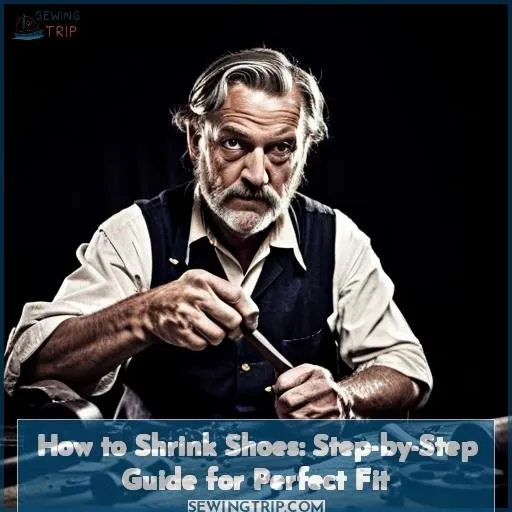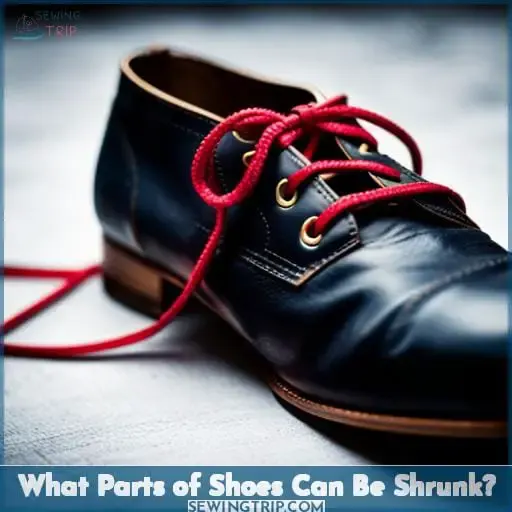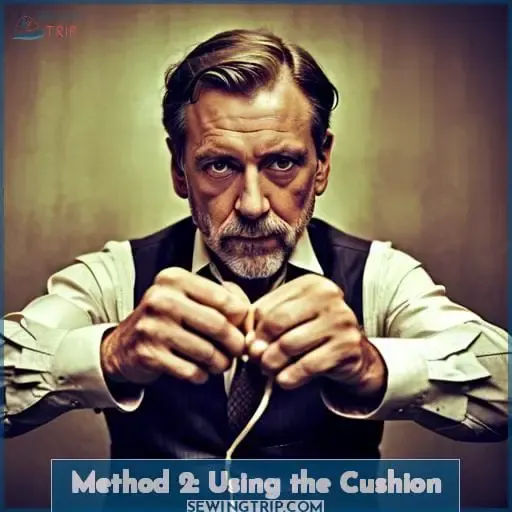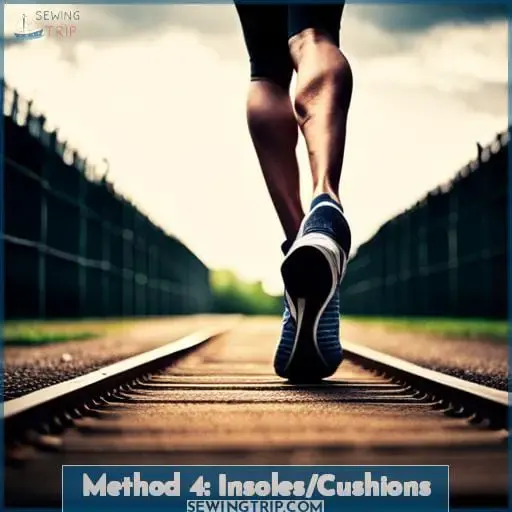This site is supported by our readers. We may earn a commission, at no cost to you, if you purchase through links.
Are you looking for a way to make your too-big shoes fit perfectly? Don’t despair – there are plenty of methods that can help! From using water and heat, to vinegar solutions, cushions or insoles; in this article we will explore how to shrink shoes with step-by-step instructions.
Whether it’s leather, canvas or suede shoes that don’t fit quite right – you’ll find the perfect solution here. We’ve also included helpful tips on what parts of the shoe can be shrunk and which materials/equipment you need for each method.
So start reading now if you want those ill-fitting shoes snugly hugging your feet!
Table Of Contents
Key Takeaways

- Different materials require different techniques for shrinking shoes.
- Heat methods like blow drying and ironing are suitable for leather or suede shoes.
- Vinegar solutions can be used for shrinking shoes, with options like white vinegar or apple cider vinegar.
- It is important to test the shrinking techniques on an inconspicuous part of the shoe first before applying them to the entire shoe.
How to Shrink Shoes
You can make your feet feel free and comfy by giving them a cozy hug with warm water! There are various techniques you can use to shrink shoes, depending on the type of material.
For leather or suede shoes, try using heat methods such as blow drying or ironing. You could also opt for vinegar methods such as soaking in white vinegar or apple cider vinegar overnight. High heels may require specialized stretching tools, which you should find at any shoe store near you.
When done correctly, these resizing techniques will ensure that your shoes fit snugly without causing discomfort to your feet.
Shoe stretching is another viable option if available space inside a shoe needs expansion rather than compression. However, this approach requires more time and patience than using heat or wetting agents when trying to shrink footwear items down in size.
What Parts of Shoes Can Be Shrunk?
Shrinking your shoes doesn’t have to be a daunting task! With the right techniques, you can give your feet some extra breathing room in no time.
There are a few parts of shoes that can be shrunk, including width, length, and shape. Ironing or steaming is an effective way to shrink leather or suede items, while stretching tools are available for high heels.
Freezing works well on canvas materials as it contracts the fabric when taken out of cold temperatures.
For those wanting more space inside their pair of shoes, shoe stretching might work better than shrinking – but this requires more patience and time than heat methods do!
To ensure success with any resizing technique being used, don’t forget to test them on an inconspicuous part first before attempting full-scale alteration.
Finally, wearing thick socks whilst trying on new pairs of footwear will help create a snug fit without having to adjust anything after purchase by using these tips from our shoe fitting guide – just make sure they aren’t slipping off either side though!
Method 1: Water and Heat
One of the quickest ways to give your shoes a snugger fit is by combining water and heat. This method works best for leather or synthetic materials, as long as you make sure to use temperature control and protect any non-heat resistant parts such as soles with tape.
Start by filling up a sink with cold water. Submerge the whole shoe in it until it’s completely saturated. After that, remove them from the water and gently squeeze out any excess remaining liquid before applying some heat.
Finally, take time to manage how hot these items get – too much could irreversibly damage your footwear! Once finished, put on thick socks if needed for extra padding around foot size. Then wear them comfortably, knowing they will now provide a better fit than before.
Method 2: Using the Cushion
Another effective shoe shrink method is using a cushion.
The first step in this process is selecting the right cushion for your shoes – it should be waterproof, durable, and provide ample support.
Once you have that picked out, it’s time to start sizing up your shoes! Start by targeting areas where there may be extra room when wearing them, such as around toes or heels.
Then use thicker pairs of socks if needed for added padding on foot size before putting cushions inside the shoe accordingly, so they fit snugly against the skin without being too tight or uncomfortable.
Lastly, consider waterproofing options like sprays, which can help protect leather materials from water damage while also providing an additional comfort level during wear!
With these simple steps followed correctly, you’ll find that not only do the shoes look better but feel more secure with every stride taken – an ideal result all-around!
Method 3: Vinegar
If you’re looking to shrink a pair of shoes, vinegar is a great option. You’ll need some materials and equipment such as white vinegar, water, cloths or towels for cleaning and drying, and a blow-dryer if necessary.
The first step is figuring out the area that needs shrinking. This might be around the toes or heels where extra space can occur when wearing them.
Then, use wet cloths with equal parts white vinegar and water solution on the target areas. Let it sit for about 10 minutes before drying with another clean cloth. Repeat the process until desired results are reached.
Lastly, after all the steps have been completed, condition your leather or suede shoes using an appropriate product to keep them in top shape.
Materials/Equipment
To shrink your shoes, you’ll need to gather supplies like a cushion for extra padding, thick socks, and waterproof spray protection. Ironing or waxing can help achieve an ideal fit, while boiling and wearing wide shoes is another effective dry method.
Step 1: Figure Out the Area That Needs to Shrink
Identify the areas of your footwear that could use a snugger fit – no need to settle for an uncomfortable shoe size. Consider the drying time and heat settings when steaming, as well as leather care if using a more delicate shoe.
It may be tempting to shrink them all at once, but it’s best to take it in stages for better control over how much they will shrink.
With these simple techniques, you’ll soon have shrunken areas where desired without compromising on comfort or style – what an easy task!
Step 2: Wet the Target Areas
Sprinkle some vinegar on the areas you want to snug up – don’t forget, slow and steady wins the race! Wearing socks can help evenly distribute moisture from your iron shrinking. Steam irons or hair dryers will also work if applied with care. Rubbing alcohol is an alternative option for a more delicate shoe, while good quality leather moisturizer should be used afterwards to keep its supple texture intact.
With a soaked rag and the help of your fingers, carefully wet each area until it’s saturated.
Step 3: Blow-dry the Wet Areas
Once the areas are saturated, use a blow dryer to quickly dry them and help shrink your favorite pair of kicks. Leather care is essential when it comes to shrinking shoes for a tight fit; heat application should be done in particular areas with caution.
Blow drying is often the best bet as it’s less invasive than other methods while still yielding results in a relatively short time.
Step 4: Condition Your Leather/Suede Shoes
After blow-drying, condition your leather or suede shoes for a better overall fit. Leather care and shoe maintenance are essential for shrinking tips. Cleaning the entire shoe with simple methods can provide great benefits; also focus on specific areas of your shoe! Try out a few tricks to keep them snuggly soft – you won’t regret it! With proper conditioning, you’ll achieve an improved fit while maintaining their look and feel.
Method 4: Insoles/Cushions
If you’re looking to get a better fit from your shoes, adding insoles or cushions is an easy way to do so. This can help prevent uncomfortable rubbing and provide extra cushioning for outdoor activities.
In such cases, it’s important that the ill-fitting shoe fits properly before any shrinking techniques are used as they may not be necessary if the right size was initially purchased.
Adding insoles or cushions could also help avoid having an unsightly look due to stretching caused by soaking in a vinegar solution or freezing them with ice cubes, which have been discussed earlier on how to shrink shoes.
Here is a list of tips on how you can add some extra comfort:
- Use foam inserts rather than liquids when testing out different sizes at stores.
- Invest in reusable leather protectors.
- Choose insoles specifically designed for your foot type.
- Consider adding additional cushioning materials depending on activity level like gel pads/spacer devices, etc.
These simple steps will make sure that any ill-fitted shoe has plenty of support underneath while providing maximum comfort throughout every step taken – no matter what kind of environment they’re subjected to!
Frequently Asked Questions (FAQs)
Can all types of shoes shrink?
Most shoes can shrink, but synthetic materials may not. A fascinating statistic is that leather can be stretched up to 20% of its original size and still retain quality! Take care when shrinking your shoes; they should fit comfortably yet snugly.
Is it safe to put shoes in the dryer?
It’s generally not safe to put shoes in the dryer. Doing so can cause shrinking, warping, and other damage that can be difficult or impossible to fix. Best practice is handwashing and air drying when attempting shoe alteration for better results with less risk of damaging your shoes.
How long should I leave the shoes in the water or heat?
You don’t want to leave your shoes in the water or heat for too long. Aim to keep it short – a few minutes should do the trick! The key is finding that balance between shrinking and not damaging them.
How often should I shrink my shoes?
Shrink your shoes as needed. Regularly check for fit and adjust accordingly to maintain comfort and support.
Are there any risks associated with shrinking shoes?
Yes, there are risks associated with shrinking shoes. Shrinking them too much can make the material brittle and prone to cracking. Additionally, not following instructions carefully may cause permanent damage to your shoes’ shape or quality.
Conclusion
After reading this article, you should have a better understanding of how to shrink shoes. Each method has its own unique benefits and drawbacks, so it’s important to choose the one that best fits your needs.
Think of the process of shrinking shoes as a journey. Not only will you learn a lot about your shoes, but you’ll also learn a lot about yourself. It takes patience and perseverance to get a good result, but the reward you get in the end is worth the effort.
So go ahead and take the plunge. You won’t regret it. Good luck!











